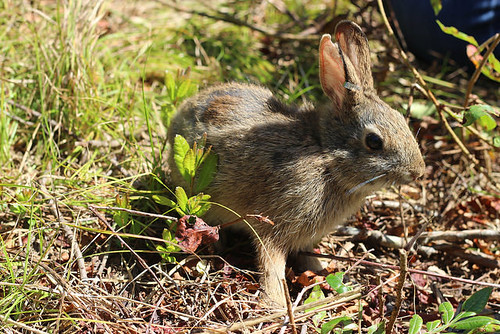
Wildlife and working lands go hand in hand. Today, thanks to the hard work of private landowners and land managers, the New England cottontail will not need protection under the Endangered Species Act.
Widespread habitat loss since the 1960s impacted New England cottontail numbers. But people like Rick Ambrose have restored habitat on private lands, putting the cottontail on the road to recovery. I had a chance to visit Rick’s place today in New Hampshire, seeing how he worked with USDA’s Natural Resources Conservation Service (NRCS) to voluntarily restore the young shrubby forests the rabbit needs.
The New England cottontail is the region’s only native rabbit, even though it looks similar to the more abundant eastern cottontail, an introduced species. In the past three years, NRCS has worked with landowners like Rick to restore more than 4,400 acres of early successional habitat in Connecticut, Maine, Massachusetts, New Hampshire, New York and Rhode Island.
Private lands play a crucial role in connecting habitat. For example, almost 100 acres of habitat was restored on three neighboring sites near Mashpee, Massachusetts when three groups coordinated their restoration efforts.
And in Connecticut, after learning their land could sew together tracts of prime cottontail habitat, the Magnuson family worked with NRCS to remove invasive plants and mature trees, allowing desired shrubs to flourish.
Conservation efforts like these are occurring across the region, benefiting the cottontail and 66 other species that depend on the same habitat, including woodcock, roughed grouse, snowshoe hares, box turtles, frosted elfin butterflies and a variety of songbirds.
Through Working Lands for Wildlife (WLFW), we’re able to target habitat restoration efforts where they can have the biggest impact. WLFW benefits wildlife as well as landowners, who receive technical and financial assistance to improve their lands as well as regulatory predictability they can maintain working lands in the long term.
We’re seeing positive outcomes for wildlife across the country. The Oregon chub was the first fish in history to be delisted, not because it was extinct, but because it rebounded. FWS recently determined the Arctic grayling and Bi-State sage-grouse did not need listing because of conservation efforts underway.
Conservation on private lands is working.
While we celebrate this success, our work isn’t over. We need to continue working on private lands in these six states to restore habitat, improve water and soil quality and strengthen rural economies.
Learn more about NRCS’ wildlife conservation efforts. For more on technical and financial assistance available through conservation programs, visit nrcs.usda.gov/GetStarted or a local USDA service center.

